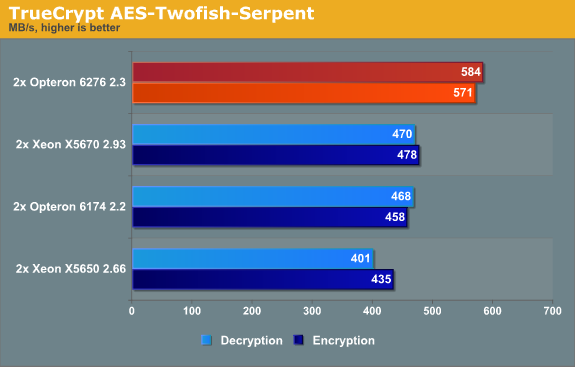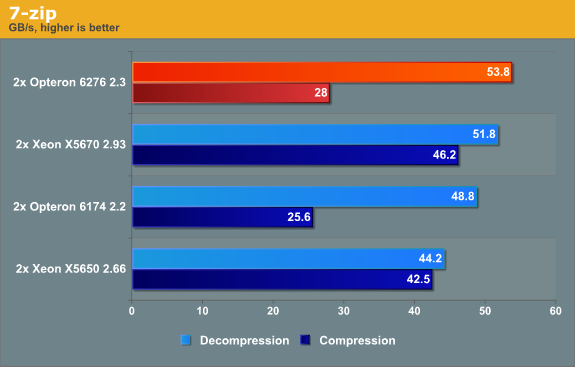Bulldozer for Servers: Testing AMD's "Interlagos" Opteron 6200 Series
by Johan De Gelas on November 15, 2011 5:09 PM ESTTrueCrypt 7.1 Benchmark
TrueCrypt is a software application used for on-the-fly encryption (OTFE). It is free, open source and offers full AES-NI support. The application also features a built-in encryption benchmark that we can use to measure CPU performance. First we test with the AES algorithm (256-bit key, symmetric).

You can compare those numbers directly with Anand's benchmark here. The Core i7-2600K at 3.4GHz delivers 3.4GB/s and the AMD FX-8150 at 3.6GHz about the same 3.3GB/s. We get about 2.3 times the performance here with four times as many "cores", but at 2.3GHz instead of 3.6GHz.
We also test with the heaviest combination of the cascaded algorithms available: Serpent-Twofish-AES.

The combination benchmark is limited by the slowest algorithms: twofish and serpent. The huge advantage that the architectures (Opteron "Bulldozer" and Xeon "Westmere") which support AES-NI had has evaporated: the Opteron 6174 keeps up with the best Xeons. The Opteron 6276 can leverage its higher threadcount as this benchmark scales extremely well.
It is good to realize that these benchmarks are not real-world but rather synthetic. It would be better to test a website that does some encrypting in the background or a fileserver with encrypted partitions. In that case the encryption software is only a small part of the total code being run. A large performance (dis)advantage might translate into a much smaller performance (dis)advantage in that real-world situation.
For example, eight times faster encryption resulted in a website with 23% higher throughput and a 40% faster encrypted file (see here). The advantage that the Xeon had in the first benchmark will not be noticeable, and the Opteron's 24% higher performance will translate into a few percentage points. But this is a benchmark where AMD's efforts to get a 16 integer cores inside a 115W TDP pay off.
7-Zip 9.2
7-zip is a file archiver with a high compression ratio. 7-Zip is open source software, and most of the source code is under the GNU LGPL license

Compression is more CPU intensive than decompression, and the latter depends a little more on memory bandwidth. When it comes to load/stores and memory bandwidth, the Opteron 6276 is unbeateable. We've also seen indications that Bulldozer's cache does very well in reads but not so well in writes, and that could account for some of the gap between the compress/decompress results.
Compression is for a part determined by the quality of the branch predictor (higher than normal branch mispredictions on mediocre branch predictors). The Opteron 6276 has a better branch predictor than the Opteron 6174, but the branch misprediction penalty has grown from 12 to 20 cycles. As a result, a single branch intensive thread runs slower (see Anand's tests) on the newest AMD architecture. Luckily, the AMD Opteron 6276 can compensate for this with its 16 threads (vs 12 threads for the Opteron 6172) and a little bit of help from Turbo Core.
Intel still has the best branch predictors in the industry. The result is that the Xeon is by far the fastest compressor. The end result is that the Xeon is the more rounded CPU in this discipline.










106 Comments
View All Comments
mino - Wednesday, November 16, 2011 - link
IT had most likely to do with you running it on NetBurst (judging by no VT-X moniker).As much to do with VT-X as with a crappy CPU ... wiht bus architecture ah, thank god they are dead.
JustTheFacts - Wednesday, November 16, 2011 - link
Please explain why there is no comparison between the latest AMD processors to Intel's flagship two-way server processors: the Intel Westmere-EX e7-28xx processor family?Lest you forgot about them, you can find your own benchmarks of this flagship Intel processor here: http://www.anandtech.com/show/4285/westmereex-inte...
Take the gloves off and compare flagship against flagship please, and then scale the results to reflect the price differece if you have to, but there's no good reason not to compare them that I can see. Thanks.
duploxxx - Thursday, November 17, 2011 - link
Westmere EX 2sockets is dead, will be killed by own intel platform called romley which will have 2p and 4p.it was a stupid platform from the start and overrated by sales/consultants with there so called huge memory support.
aka_Warlock - Wednesday, November 16, 2011 - link
I think you should have done a more thorough VM test than you did. 64GB RAM?We all know single threaded performance is weak, but I still feel the server are underutilized in your test.
These CPU's are screaming heavy multi threading workloads. Many VM's. Many vCPU's.
What would the performance be if you had, say, at least 192GB of RAM and 50 (maybe more) VM's on it?
And offcourse, storage should not be a bottleneck.
I think this is where his 8modules/16threads cpu would shine.
A dual socket rack/blade. 16modules/32 threads.
Loads of RAM and a bounch of VM's.
iwod - Wednesday, November 16, 2011 - link
It is power hungry, isn't any better then Intel, and it is only slightly cheaper, at the cost of higher electricity bill.So unless with some software optimization that magically show AMD is good at something, i think they are pretty much doomed.
It is like Pentium 4, except Intel can afford making one or two mistakes, but not with AMD.
mino - Wednesday, November 16, 2011 - link
Then the article served its purpose well.SunLord - Wednesday, November 16, 2011 - link
So is the AMD system running 8GB DDR3-1600 DIMMS or 4GB DDR3-1333? Because you list the same DDR3-1333 model for both systems and if the Server supports 16 DIMMs well 16*4 is 64GBJohanAnandtech - Thursday, November 17, 2011 - link
Copy and paste error, Fixed. We used DDR-3 1600 (Samsung)Johnmcl7 - Wednesday, November 16, 2011 - link
I have wondered about this, with more cores per socket and virtualisation (organising new set of servers and buying far less hardware for the same functionality) so I'd have thought in total less server hardware is being purchased. Clearly that isn't the case though, is the money made back from more expensive servers?John
bruce24 - Wednesday, November 16, 2011 - link
While sure which each new generation of server you need much less hardware to do the same amount of work, however worldwide people are looking for servers to do much more work. Each year companies like Google, Facebook, Amazon, Microsoft and Apple add much more computing power than they could get by refreshing their current servers.